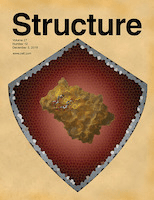
BIOPHYSICAL JOURNAL
Scope & Guideline
Unveiling the complexities of biological phenomena.
Introduction
Aims and Scopes
- Molecular Dynamics Simulations:
Utilizes advanced computational techniques to model the behavior and interactions of biomolecules, providing insights into their dynamics and structural changes. - Single-Molecule Techniques:
Employs methods such as single-molecule FRET and optical tweezers to investigate the interactions and conformational changes of proteins and nucleic acids at unprecedented resolution. - Biophysical Characterization of Membranes:
Explores the physical properties of lipid bilayers and membrane proteins, contributing to the understanding of membrane dynamics, transport mechanisms, and signal transduction. - Structural Biology:
Focuses on elucidating the three-dimensional structures of proteins, nucleic acids, and complexes using techniques like cryo-EM and X-ray crystallography to understand their functional roles. - Mechanobiology:
Investigates how mechanical forces influence cellular behavior, including migration, differentiation, and mechanotransduction, bridging the gap between physical stimuli and biological responses. - Phase Separation in Biology:
Studies the formation and dynamics of biomolecular condensates, exploring their roles in cellular organization, signaling, and disease processes. - Drug Discovery and Development:
Integrates biophysical techniques to assess ligand-receptor interactions, understand drug mechanisms, and develop therapeutics targeting various biological pathways.
Trending and Emerging
- Artificial Intelligence and Machine Learning:
The integration of AI and machine learning techniques in biophysical research is on the rise, aiding in data analysis, predictive modeling, and the design of novel biomolecular interactions. - Biomolecular Condensates and Phase Separation:
Research into the role of biomolecular condensates in cellular organization and function is rapidly expanding, particularly in understanding their implications in diseases such as cancer and neurodegeneration. - Advanced Imaging Techniques:
There is an increasing focus on developing and applying high-resolution imaging methods, such as super-resolution microscopy and cryo-electron tomography, to study complex biological systems in real-time. - Mechanobiology and Cellular Mechanics:
Emerging studies are exploring how mechanical forces influence cellular behavior, linking physical properties to biological functions and highlighting the relevance of mechanotransduction pathways. - Synthetic Biology and Protein Engineering:
The trend towards designing and engineering proteins with novel functionalities is gaining momentum, driven by advances in computational tools and synthetic biology approaches. - Membrane Protein Dynamics:
Research is increasingly focused on understanding the dynamics and interactions of membrane proteins, particularly in the context of their roles in signaling and transport.
Declining or Waning
- Traditional Biochemical Methods:
The reliance on conventional biochemical assays is waning as more researchers turn to advanced imaging and computational methods that provide greater insights into molecular dynamics. - Static Structural Studies:
There is a noticeable decrease in publications focusing solely on static structures, as the field gravitates towards studies that incorporate dynamic and functional aspects of biomolecules. - In Vitro Studies:
As in vivo and organoid models gain popularity, the emphasis on purely in vitro studies is diminishing, reflecting a trend towards more physiologically relevant experimental systems. - Basic Enzyme Kinetics:
Research on fundamental enzyme kinetics is becoming less prominent as studies increasingly emphasize complex interactions and regulatory mechanisms in cellular contexts.
Similar Journals

JOURNAL OF MEMBRANE BIOLOGY
Unveiling the Secrets of Biological MembranesWelcome to the Journal of Membrane Biology, a premier publication dedicated to advancing our understanding of the complex roles membranes play in biological systems. Published by Springer, this journal features research articles, reviews, and communications on a broad range of topics related to membrane biology, including biomolecular interactions, transport mechanisms, and physiological responses. With an ISSN of 0022-2631 and E-ISSN 1432-1424, the journal has been a cornerstone in the field since its inception in 1969 and continues to thrive as it looks towards 2024. Ranked in the second quartile (Q2) for Biophysics and Physiology, and third quartile (Q3) in Cell Biology, it showcases impactful research that embodies the spirit of scientific inquiry and innovation. Although currently not an Open Access journal, it remains easily accessible to researchers, professionals, and students eager to delve into the dynamic world of membrane studies. As the understanding of membrane dynamics expands, so does its relevance in areas such as drug development and cellular engineering, making the Journal of Membrane Biology an essential resource for those at the forefront of these critical scientific advancements.

BIOCHIMICA ET BIOPHYSICA ACTA-BIOMEMBRANES
Pioneering Research in Biochemistry and BiophysicsBIOCHIMICA ET BIOPHYSICA ACTA-BIOMEMBRANES is a prestigious journal dedicated to advancing the field of biomembrane research, published by Elsevier. With a notable track record since its inception in 1967, this journal operates under the dual ISSN 0005-2736 and E-ISSN 1879-2642, and has firmly established itself within the scientific community by ranking in the top tiers of various disciplines, including Q2 in Biochemistry and Cell Biology, and Q1 in Biophysics as of 2023. Its impressive Scopus rankings further underscore its importance, with a rank of 24 in Biophysics reflecting its strong impact on ongoing research. Although it does not offer open access, the journal provides comprehensive insights and breakthroughs essential for scientists, researchers, and advanced students focused on biophysical and biochemical aspects of membranes. By disseminating pivotal findings, BIOCHIMICA ET BIOPHYSICA ACTA-BIOMEMBRANES contributes significantly to understanding cellular mechanisms, thereby serving as a vital resource for professionals aiming to explore the complexities of biological membranes.

BIOCHIMICA ET BIOPHYSICA ACTA-PROTEINS AND PROTEOMICS
Catalyzing Innovations in Protein ResearchBIOCHIMICA ET BIOPHYSICA ACTA-PROTEINS AND PROTEOMICS, published by Elsevier, is a prestigious academic journal that serves as a vital resource for researchers, professionals, and students in the fields of biochemistry, biophysics, and proteomics. With an ISSN of 1570-9639 and an E-ISSN of 1878-1454, this journal features high-impact research articles aimed at advancing our understanding of protein structure, function, and interactions, contributing significantly to both theoretical and applied sciences. Recognized for its quality, it proudly holds a Q1 ranking in Analytical Chemistry and Biophysics, and Q2 in Biochemistry for 2023, alongside notable Scopus rankings that reflect its influence in the realm of molecular biology. The journal's commitment to disseminating essential findings supports the ongoing evolution of proteomic sciences and encourages collaborative discourse among the global scientific community. For aspiring authors, the journal offers open access options, enabling broad visibility of their work. Join the conversation in this dynamic field and contribute to shaping the future of protein research!

BIOLOGICHESKIE MEMBRANY
Unveiling the Secrets of Cellular StructuresBIOLOGICHESKIE MEMBRANY is a critical journal in the field of Cell Biology and Molecular Biology, published by MEZHDUNARODNAYA KNIGA in the Russian Federation. With an ISSN of 0233-4755, this journal has been serving the academic community since 1996 and continues to publish cutting-edge research that advances our understanding of biological membranes and their functions. Despite being classified in Q4 quartiles for both Cell and Molecular Biology in the 2023 category rankings, the journal presents a unique platform for emerging research within these pivotal areas. Researchers, professionals, and students alike will find valuable insights in its pages as it seeks to foster a collaborative environment that encourages knowledge sharing. Although currently not available as an open-access journal, it remains an essential resource for those looking to deepen their knowledge and contribute to ongoing discussions in the biological sciences. The journal’s commitment to publishing quality research is underscored by its continuous coverage until 2024, making it a sustained reference in the field.

CHEMISTRY AND PHYSICS OF LIPIDS
Unraveling the mysteries of lipids in health and disease.Chemistry and Physics of Lipids is a prestigious and influential journal dedicated to advancing the understanding of lipid chemistry and biophysics. Published by Elsevier Ireland Ltd, it serves as a vital resource for researchers and professionals in the fields of biochemistry, cell biology, and molecular biology. The journal has a strong standing within the academic community, as reflected in its 2023 Scopus rankings, where it places in the 82nd percentile for organic chemistry and maintains significant positions in various biochemistry subfields. Spanning from 1966 to 2024, it fosters a comprehensive discourse on lipid-related research and innovation. As a renowned publication in the Q2 and Q3 quartiles across several categories, it supports the dissemination of high-quality research aimed at elucidating lipid functions and their implications in health and disease. Researchers and students alike will find this journal invaluable for staying updated with the latest developments and trends in lipid research.

Biochemistry Moscow Supplement Series A-Membrane and Cell Biology
Exploring the Frontiers of Membrane DynamicsBiochemistry Moscow Supplement Series A-Membrane and Cell Biology, published by PLEIADES PUBLISHING INC in the United States, is a pivotal journal in the fields of biochemistry, biophysics, and cell biology. Established in 2008, this journal has become a significant platform for disseminating novel research findings and reviews, fostering advanced studies in membrane dynamics and cellular processes. Although currently ranked in the Q4 quartile across its categories, the journal provides researchers and professionals with open access to a wealth of knowledge, helping to bridge gaps in understanding complex biochemical mechanisms. The journal’s commitment to quality and relevance is evident as it continues to contribute to the academic community through its coverage of innovative and emerging topics in cell and membrane biology. Researchers, practitioners, and students alike will find this resource invaluable for keeping abreast of the latest developments in the ever-evolving landscape of biochemistry and cellular research.

BIOCHEMISTRY
Unveiling the molecular mysteries of biochemistry.BIOCHEMISTRY is a premier academic journal published by the American Chemical Society, dedicated to advancing the field of biochemistry through the dissemination of high-quality research. With an ISSN of 0006-2960 and an e-ISSN of 1520-4995, this esteemed publication has been a vital resource since its inception in 1962 and continues to contribute to the scientific community, boasting a remarkable Q1 ranking in the field as of 2023. The journal's well-curated content emphasizes fundamental biochemical research, molecular genetics, and innovations in biochemical techniques, catering to a diverse audience of researchers, professionals, and students. Although not an open-access publication, BIOCHEMISTRY plays a crucial role in facilitating knowledge exchange and fostering academic collaboration globally, making significant contributions to the understanding of the biochemical processes that underpin life.

FEBS LETTERS
Where Innovation Meets Biological DiscoveryFEBS LETTERS, published by Wiley, is a prestigious journal that has firmly established its place in the fields of biochemistry, biophysics, genetics, molecular biology, cell biology, and structural biology. With an esteemed history dating back to 1968, this journal continues to be a vital resource for researchers and professionals involved in the biological sciences. It boasts impressive quartile rankings, including Q1 statuses in several categories such as Biochemistry and Genetics, reflecting its high impact factor and significant contribution to scientific discourse. FEBS LETTERS provides a platform for innovative findings and critical reviews, fostering the exchange of knowledge and ideas within the scientific community. Although it operates under a subscription model, the journal ensures broad dissemination of groundbreaking research through its rigorous peer-review process. The vibrant discussions encouraged by articles published in FEBS LETTERS aim to inspire current and future generations of scientists to push the boundaries of biological understanding, making it an indispensable resource for anyone dedicated to advancing their knowledge in these dynamic fields.

STRUCTURE
Fostering groundbreaking insights into molecular mechanisms.STRUCTURE is a premier academic journal published by CELL PRESS, dedicated to advancing the field of structural biology and molecular biology since its inception in 1993. With an impressive reputation, it is recognized as a Q1 journal in both Molecular Biology and Structural Biology categories, reflecting its high impact within the academic community. The journal holds a significant position in Scopus rankings, placing 10th among 49 in Structural Biology and 100th among 410 in Molecular Biology, marking it as a key resource with a strong influence on ongoing research. Researchers and professionals alike will find STRUCTURE an invaluable platform for disseminating cutting-edge findings related to protein structure, dynamics, and interactions, fostering insights that can lead to groundbreaking applications in medicine and biotechnology. Although the journal follows a traditional subscription model, it continues to attract a diverse array of submissions, ensuring a vibrant exchange of knowledge in the ever-evolving landscape of structural and molecular biology. Access to its content can enhance the understanding of intricate biological mechanisms, making it essential reading for experts, students, and anyone passionate about the molecular underpinnings of life.

JOURNAL OF BIOLOGICAL PHYSICS
Unraveling the Physics of LifeThe JOURNAL OF BIOLOGICAL PHYSICS, published by Springer, is a premier interdisciplinary journal that focuses on the intersection of biological sciences and physics. With an ISSN of 0092-0606 and an E-ISSN of 1573-0689, this journal serves as a significant platform for researchers and professionals to publish innovative studies, covering fields such as atomic and molecular physics, biophysics, cell biology, and molecular biology. The journal has been a key player since its inception in 1973, showcasing rigorous scientific inquiry and advancing knowledge within these domains, reflected in its categorization in the Q3 and Q4 quartiles of various relevant fields as of 2023. While it currently operates without an Open Access model, the journal continues to provide pivotal contributions to its audience, supporting academic and practical advancements in biological physics while engaging a broad scope of scholarly discourse.